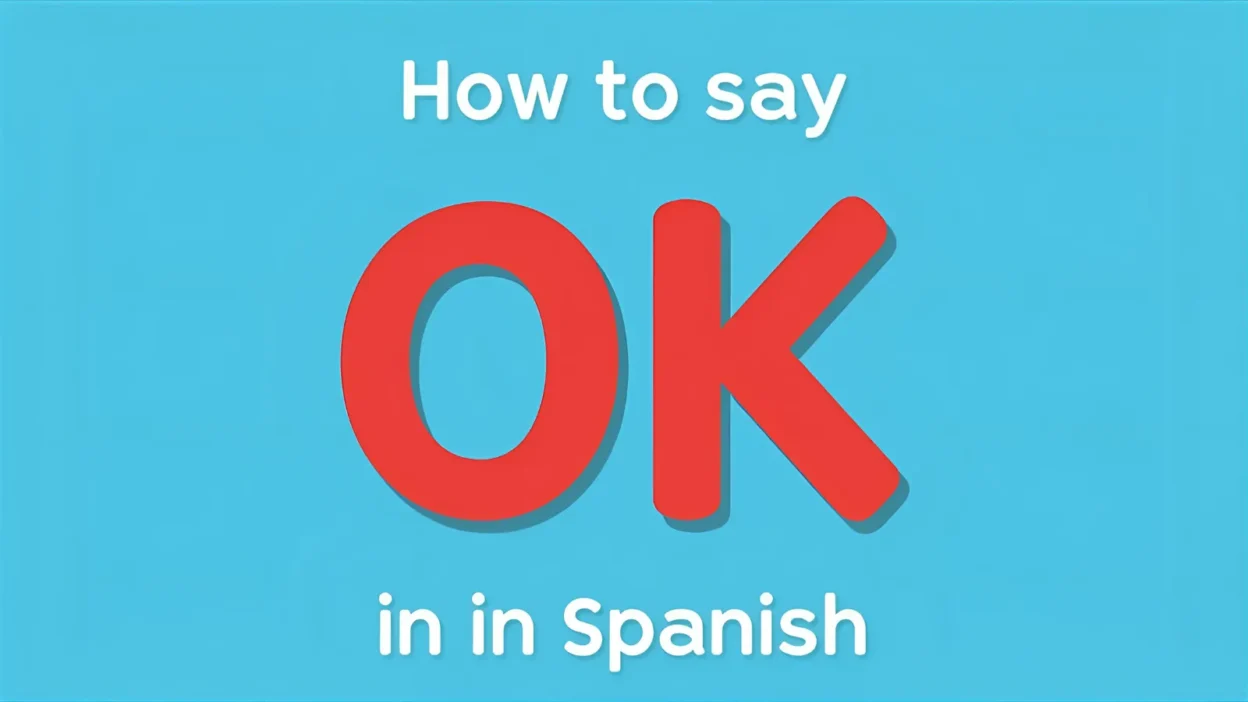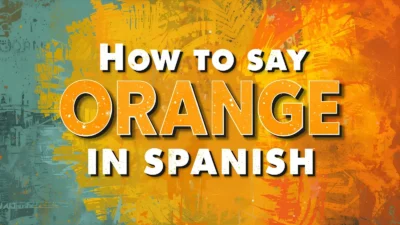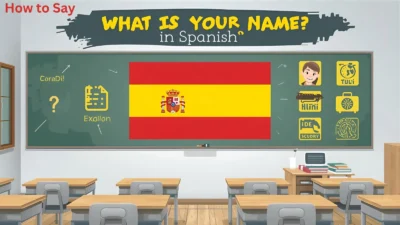How to Say OK in Spanish is one of the simplest yet most useful phrases you can learn. Whether you’re agreeing with someone, confirming a plan, or just casually responding, knowing different ways to say OK will make your Spanish sound natural and fluent.
From the common vale in Spain to okey and está bien in Latin America, there are many options to choose from. Mastering these phrases will help you respond naturally in everyday conversations.
Say OK in Spanish
15 Ways to Say OK in Spanish
| No. | Spanish Phrase | Pronunciation | Meaning / Usage |
|---|---|---|---|
| 1 | Vale | VAH-leh | Common in Spain, means “OK / alright” |
| 2 | Está bien | Es-TAH byehn | It’s fine, that’s OK |
| 3 | Okey | OH-key | Borrowed from English, casual |
| 4 | De acuerdo | Deh ah-KWEHR-do | Agree, all right |
| 5 | Claro | KLAH-ro | Sure, of course, OK |
| 6 | Perfecto | Pehr-FEK-toh | Perfect, all good |
| 7 | Muy bien | Mwee byehn | Very well, OK |
| 8 | Sin problema | Seen pro-BLEH-mah | No problem, OK |
| 9 | Correcto | Koh-REK-toh | Correct, that’s OK |
| 10 | Listo | LEES-toh | Ready, OK |
| 11 | Bien | Byen | Good, OK |
| 12 | Está claro | Es-TAH KLAH-ro | It’s clear, OK |
| 13 | Conforme | Kon-FOR-meh | In agreement, OK |
| 14 | Hecho | EH-choh | Done, OK |
| 15 | Trato hecho | TRAH-toh EH-choh | Deal done, OK |
Here are 15 ways to say OK in Spanish, each with a real-world dialogue and a note on where or how it’s used.
1. Está bien – It’s fine / OK

Origin:
Literally means “It is well.” This is the most direct and neutral translation of “OK.”
Example:
👤 User A: ¿Quieres salir a las 6?
👤 User B: Está bien, me parece perfecto.
Use: Neutral; works in all Spanish-speaking regions.
2. Vale – OK / Sure
Origin:
Used mostly in Spain, “vale” comes from the verb valer (to be worth or valid). It’s a go-to in casual and even formal conversations.
Example:
👤 User A: Te llamo mañana, ¿vale?
👤 User B: Vale, hablamos luego.
Use: Common in Spain; less used in Latin America.
3. OK – Okay (borrowed from English)
Origin:
Yes, “OK” itself is used in Spanish too, especially in texting or informal speech, thanks to pop culture and technology.
Example:
👤 User A: Te mando el archivo ahora.
👤 User B: OK, gracias.
Use: Universal; understood everywhere, informal.
4. De acuerdo – Agreed / OK

Origin:
Means “in agreement.” It’s more formal than “vale” and works well in business or respectful settings.
Example:
👤 User A: ¿Confirmamos la reunión a las 10?
👤 User B: De acuerdo, estaré allí.
Use: Formal to neutral; ideal for professional situations.
5. Está claro – Alright / Got it
Origin:
Literally “It’s clear.” Used to confirm understanding.
Example:
👤 User A: No se puede fumar aquí.
👤 User B: Está claro, no hay problema.
Use: Common in Spain; polite confirmation.
6. Listo – OK / Ready
Origin:
“Listo” means “ready,” but in Latin America, it’s often used to mean “OK” or “Understood.”
Example:
👤 User A: Nos vemos a las 8.
👤 User B: ¡Listo!
Use: Widely used in Latin America, especially Colombia.
7. Perfecto – Perfect / OK

Origin:
Just like in English, “Perfecto” expresses strong agreement or approval.
Example:
👤 User A: Ya tengo todo listo.
👤 User B: Perfecto, empezamos entonces.
Use: Emphatic approval; used everywhere.
8. Claro – Sure / OK
Origin:
Means “clear” but used to mean “Of course” or “OK.”
Example:
👤 User A: ¿Puedes ayudarme un momento?
👤 User B: Claro, dime.
Use: Friendly, everyday use in all Spanish-speaking countries.
9. Bueno – Alright / OK
Origin:
Means “good,” but also used to transition or accept something.
Example:
👤 User A: ¿Vamos ahora?
👤 User B: Bueno, vamos.
Use: Neutral; used across Spanish dialects.
10. Entendido – Understood / OK
Origin:
From the verb entender (to understand). Used when confirming instructions or rules.
Example:
👤 User A: No puedes tocar eso, ¿entendido?
👤 User B: Entendido.
Use: Formal, often military or professional tone.
11. Ya – OK / Got it
Origin:
Means “already,” but in slangy usage, it’s a quick way to say “alright.”
Example:
👤 User A: ¡Cállate ya!
👤 User B: Ya, tranquilo.
Use: Contextual; can mean “OK” in tense or emotional conversations.
12. Afirmativo – Affirmative
Origin:
Borrowed from military and aviation jargon.
Example:
👤 User A: ¿Recibiste el mensaje?
👤 User B: Afirmativo.
Use: Military-style or humorous/formal situations.
13. Está bien así – That’s fine the way it is
Origin:
Expanded version of “Está bien” to emphasize acceptance.
Example:
👤 User A: ¿Quieres que lo cambie?
👤 User B: No, está bien así.
Use: Polite and reassuring.
14. Sí, cómo no – Of course / OK
Origin:
Literally “Yes, why not?”—used to show strong agreement or willingness.
Example:
👤 User A: ¿Me puedes ayudar?
👤 User B: Sí, cómo no.
Use: Courteous; common in Mexico and the Caribbean.
15. Va – OK / Cool
Origin:
Short for “vale” or from the verb ir (to go), “va” is a casual way to agree in Mexico and parts of Latin America.
Example:
👤 User A: ¿Cenamos juntos esta noche?
👤 User B: ¡Va! Me encantaría.
Use: Very informal; youth slang in Latin America.
FAQs
1. What is the most common way to say “OK” in Spanish?
The easiest and most common way is simply “OK” — Spanish speakers use it just like in English!
2. Is “OK” understood everywhere in Spanish-speaking countries?
Yes, “OK” is universal and understood almost everywhere in the Spanish-speaking world.
3. What are other ways to say “OK” in Spanish?
You can also say “Está bien” (It’s fine), “Vale” (Okay), or “De acuerdo” (Agreed).
4. What does “Vale” mean and where is it used?
“Vale” means “okay” or “alright,” and it’s most common in Spain.
5. What about Latin America — do they use “Vale”?
In most of Latin America, people prefer “Está bien” or “De acuerdo” instead of “Vale.”
6. How do you say “OK” informally with friends?
You can say “Bueno”, “Dale”, or even “Va”, depending on the region.
7. What does “Dale” mean in Spanish?
“Dale” literally means “give it,” but it’s used like “go ahead” or “OK” in many Latin countries, especially Argentina and Venezuela.
8. How do you say “It’s OK” in Spanish?
You can say “Está bien” or “No pasa nada” (It’s no big deal).
9. Is there a polite way to say “OK” in Spanish?
Yes — “De acuerdo” is more polite and formal, meaning “I agree” or “That’s fine.”
10. How do you write “OK” in text messages in Spanish?
People often just write “Ok,” “Okey,” or even “Vale.” All are perfectly normal in chats and casual texts.
Conclusion:
Learning how to say OK in Spanish gives you the flexibility to respond naturally in any situation. From casual chats with friends to formal conversations, phrases like vale, está bien, or okey will make your Spanish sound authentic and confident. By using the right expression, you’ll not only communicate clearly but also connect more easily with native speakers.



